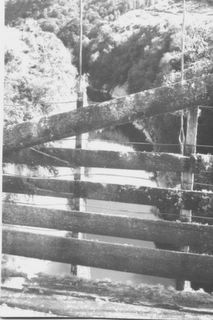More Te Rata History
The Te Rata farm is situated on the north bank of the Retaruke
River about 5k from its confluence with the Whanganui. The
house, built on a small flat paddock above a narrow gorge of the
Retaruke, was originally known as the Wade Homestead, Mrs Wade
being a Lacy from further downriver. The only reasonable access
to the house from the Raurimu-Whakahoro Rd was by way of a
traffic-width swingbridge, with massive uprights and "cables" made
from the good kiwi expedient of wrapping together clusters of
No.10 fencing wire. From any distance they appeared to be
genuine cables about 40-50 mm in diameter. The bridge was said
to be about a hundred feet above the water. When I first
encountered this fearsome bridge in the 40s, vehicles had long
since been unable to use it, owing to the very questionable state
of repair of the decking timbers in particular, but also because
of justified anxiety about the bridge's load-bearing capacity.
As a young greenhorn teacher, I was about to board at the Te Rata
homestead with the Hayes family, four of whom I would actually
teach. My first terrified crossing of the bridge was preceded by
this pack of lively mischievous kids running across with my bags
in an old farm wheelbarrow, and taking great delight in making the
bridge whip and shake as I carefully picked out the parts of the
decking which were safe to step on. About a third of the planks
were missing altogether at that stage, and another third
completely unnailed, and I still find it incredible that I
actually learned to cycle across within a couple of weeks of trial
and heart-stopping error. This infamous bridge I will refer to
hence as the Hayes Bridge, as distinct from the Berryman Bridge of
recent history, which I understand replaced the awesome Hayes on the same site.

The Hayes Bridge from upstream
The district, part of the Lower Retaruke, was called Whakahoro,
which I think means "canoe launching place", and more specifically
describes the settlement at the confluence with the Whanganui,
where the Lacy family settled and lived for many years. The
school was down there and called Whakahoro also, as was Wade's
Landing, on the Whanganui below the Retaruke. The local Post
Office was at the Dobbs farm-house just upstream from Te Rata, and
was called Retaruke.
I visited Te Rata twice in later years, in the 60s and then the
70s, and by that time, the Hayes bridge had had its decking
completely renewed, but it was still closed to vehicular traffic.
Mr & Mrs Hayes told most graphically the story of an insurance
agent who hadn't been told that, and they were astonished as they
returned from the back paddocks to see a CAR, the first one in 50
years (?), making its way along the grass drive toward the house.
When they approached the driver, whose face was of parchment
hue, he spat out, "Boy, what a bloody bridge! I'm certainly not
going back that way!" The reply he got was, "Well, yes, you are!"
Fred Hayes, who was a rough diamond but a great raconteur, had
always said that the first thing to go on that bridge would be the
cables, but it wouldn't be a problem if you were on the bridge
when it happened, as you'd hear the ping .. ping.. ping as the
No. 10 wires snapped in turn. You'd have plenty of time to get
off! But in fact, the cables were not the first thing to break.
The Te Rata woolshed was on the south side of the river, on the
same side as the road, and so the Hayes Bridge was regularly used
for the movement of sheep to and from the woolshed. I saw two
lambs fall through the faulty decking in 1947, and later watched
them being reared back to health by the Hayes family, by means of
splints on the lambs' legs. But late in the 70s, two of the Hayes
boys, one on each side of the river, watched the old bridge
collapse, as they were trying to control a mob of lambs on the
bridge, when things had gone wrong with the dogs. What actually
went first was one of the huge wooden uprights which carried the
cables and the whole weight of the bridge and its load. When
the Berrymans took over from the Hayes, there was no bridge access
to the house, and the cross-country route over Te Rata farm and
the Lacy country must have been tractor material for any kind of load.
Long before the ill-fated collapse of the Berryman Bridge, I had
recorded a radio documentary broadcast in the Spectrum series on
Radio NZ, in which I referred to the terrible plight of Mrs Hayes,
who had been left without a water tap in the house, after her only
water supply, a corrugated iron roofwater tank, had been taken
away and rolled across the rickety bridge to be set up at the
woolshed for the sheep to be dipped. For the rest of that year,
the tank never came back, and Fred, kind man that he was (?), had
boxed a freshwater spring in the bush to the east of the house, so
that his long-suffering wife could carry water all day long in a
small cream can. When Margaret Berryman heard that programme,
the house water supply was still most unsatisfactory, and they
didn't know about the spring. So off they went into the bush and
found it, and they set up the best house water supply that the
farm had ever had. Margaret Berryman wrote me a letter of
thanks at that point, and in it mentioned the bridge that had been
built by the Army's Fijian trainees out of materials paid for by
the Berrymans.
For the rest of the Berryman story, readers are referred to the
Berryman-saga link, where the whole sorry business is described
in detail, from the death of Kenneth Richards, beekeeper, whose
laden truck crashed through the bridge, through the wrongful
prosecution of the Berrymans for having an unsafe workplace to the
several appeals and reviews and coroner's inquests, which left the
Berrymans penniless, ill and devastated. A second inquest may
still be called, though the Berrymans have not been found utterly
blameless for the eventual collapse of the bridge. The Army,
however, is now seen as responsible as well, for matters of design
and construction, matters that have only recently been revealed by
the release of the Butcher Report on the Internet.




